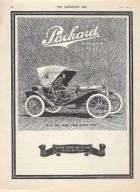|
Re: Removal of gas sending unit?
|
||||
|---|---|---|---|---|
|
Forum Ambassador

|
What year/body style etc. are you working on? Sometimes it is helpful to give that also as it might be different from series to series or year to year.
Posted on: 2008/5/5 0:03
|
|||
|
||||
|
Re: Removal of gas sending unit?
|
||||
|---|---|---|---|---|
|
Forum Ambassador

|
There may indeed have been a special tool for removing the tabbed locking ring, but I've never seen one or heard of one. Try a little PB blaster, and just keep tapping on the ears, alternating sides, and it should come free. Be gentle and patient, it's not a part I'd care to have to make.
Posted on: 2008/5/5 8:51
|
|||
|
||||
|
Re: Removal of gas sending unit?
|
||||
|---|---|---|---|---|
|
Forum Ambassador
|
It's just a few ramps that compress ring against the top piece on tank-- the more you twist, the more pressure on sender againt cork gasket. Nothing should be locked or need a special tool unless one of ramps damaged or the ring fit is bad & has moved enough to allow back of one of ramps to catch against something. Also, since it doesn't move, I'd check very carefully and see if any evidence a previous removal had some gasket cement used during replacement that might have squeezed out & hardened.
Posted on: 2008/5/5 9:36
|
|||
|
||||
|
Re: Removal of gas sending unit?
|
||||
|---|---|---|---|---|
|
Home away from home

|
Randy, It is a 56 Patrician.
Owen, I did spray 3 times it with PB Blaster after wire brushing with a brass brush. I also sprayed it as I "gently" tapped the ears CCW. You are right, I sure don't want to damage it trying to get it out. The ears are pretty sharp so wooden blocks don't work well. I'll buy a plastic faced hammer. i had a brass hammer but, it apparently ran away from home or found a good hiding place. Thanks to you both.
Posted on: 2008/5/5 9:38
|
|||
|
||||
|
Re: Removal of gas sending unit?
|
||||
|---|---|---|---|---|
|
Forum Ambassador
|
I would mill a piece of oak,maple or other hardwood, pine will just give and develop indentations
Posted on: 2008/5/5 10:30
|
|||
|
||||
|
Re: Removal of gas sending unit?
|
||||
|---|---|---|---|---|
|
Home away from home

|
Mr PB, Yeah, I have some old oak material around here I can try.
Thanks.
Posted on: 2008/5/5 10:36
|
|||
|
||||
|
Re: Removal of gas sending unit?
|
||||
|---|---|---|---|---|
|
Forum Ambassador

|
I believe there was a special spanner to facilitate removal and installation of the locking ring - though it probably wasn't listed by Packard as a special tool for dealers. The basic design of that locking ring is still in use today, though there have been myriad changes in diameters - and with spanners to match every darned one of them.
However, when the locking ring is not badly rusted, I've removed them by tapping on alternate ears with an old flat-blade screwdriver, driven by a mallet. Of course, you'd want to avoid making any sparks. About 15 years ago, I found a match to the locking ring and seal on the shelf at the Chevy-Buick store that my dad was working at. Darned if I can find the P/N for them now, but mhy dad felt that GM truck models had still used those same parts for decades after Packard was gone.
Posted on: 2008/5/5 11:50
|
|||
|
||||
|
Re: Removal of gas sending unit?
|
||||
|---|---|---|---|---|
|
Home away from home

|
Thanks to all of you for your input and suggestions.
Good news first, I got it out with no sweat. Seems today was a good one as things seemed to go as they should. I couldn't find the piece of oak that I have kept around for more years than I care to remember. I used the plastic end of an old wood chisel (very hard american made plastic) and tapped each ear with it and "voila" it came right out. I believe it is the original sender. Sometimes it seems just having someone indicating it can be done is just the ticket. I tested sender by running a jumper from the terminal at the tank (orange wire #60) and moved the float up and down and the gauge moved but almost imperceptibly. I then checked the resistance of the sender with digital ohmeter and at first all I was reading was "overload", but after moving the float arm up and down several times I was reading about 140 to 160 ohms at the bottom and a range of 150 160 ohms at the top but nothing in between the top and bottom. Seems the sender is bad, but can't tell if the gauge is bad or good. Guess I'll check out the Ford 1957/1960 sender unit if NAPA or someone has one available.
Posted on: 2008/5/5 21:24
|
|||
|
||||
|
Re: Removal of gas sending unit?
|
||||
|---|---|---|---|---|
|
Home away from home
|
You might want to check out an earlier thread titled "Fuel Tank Surprise" for explanation of the operation of Packard fuel guage.
Quote from that thread: The way the Packard gauge works is a small heating coil works on a bimetallic strip which moves with temperature change and is linked to needle. At empty, the resistance is high so very little current flows to heater, so very little heat up, and almost no movement of needle. At full, there is only a slight bit of resistance, so the heater is on and able to move the needle to maximum
Posted on: 2008/5/5 22:31
|
|||
|
||||








